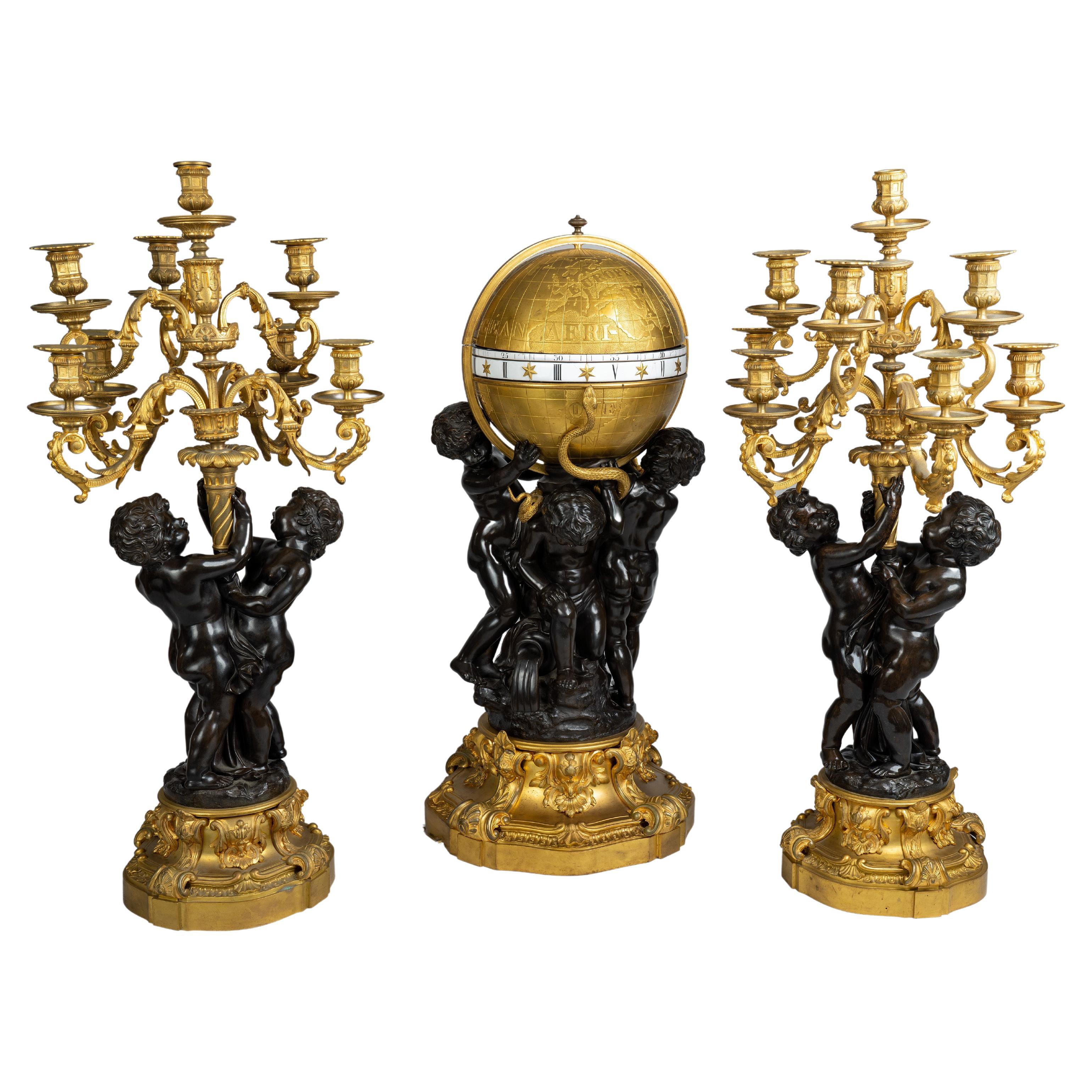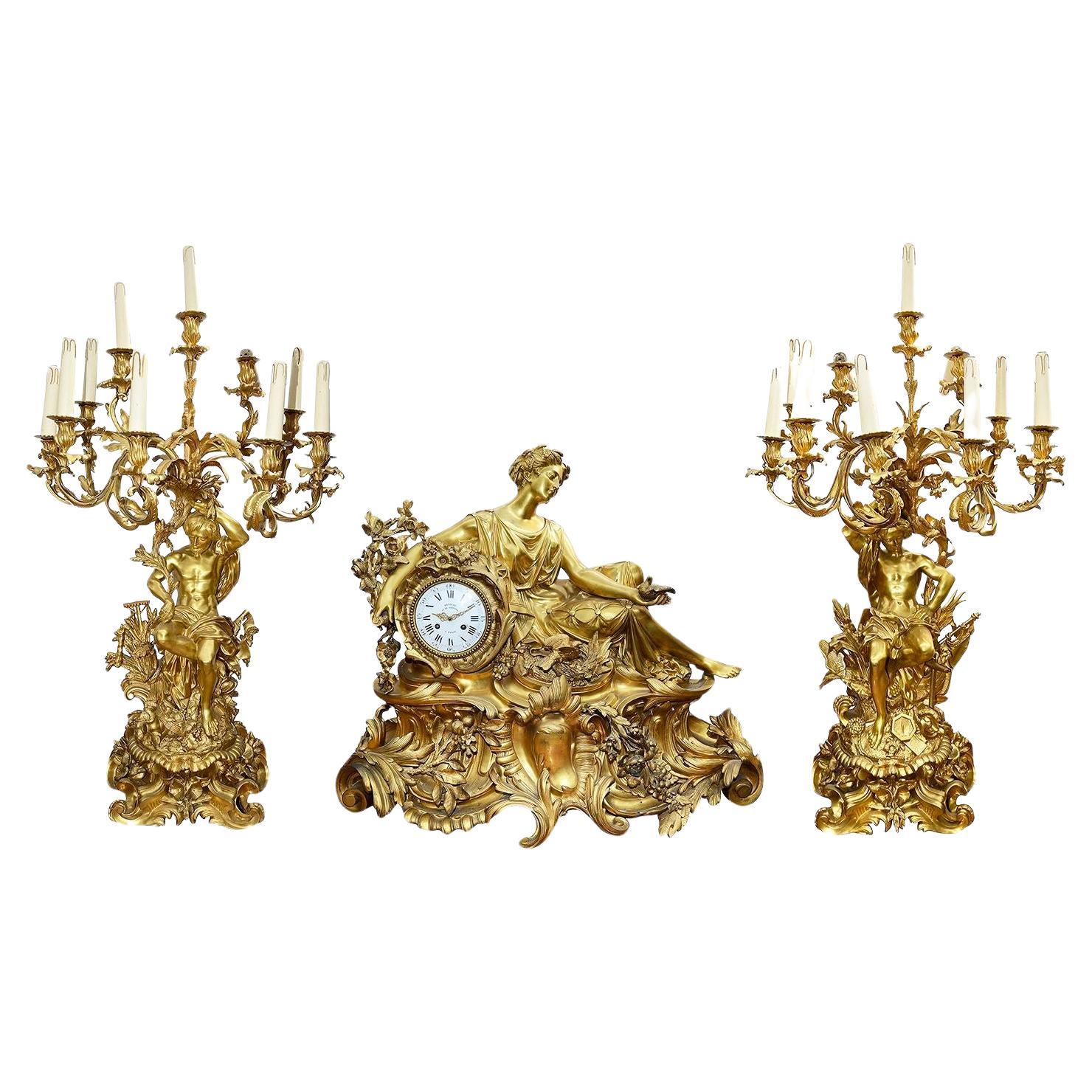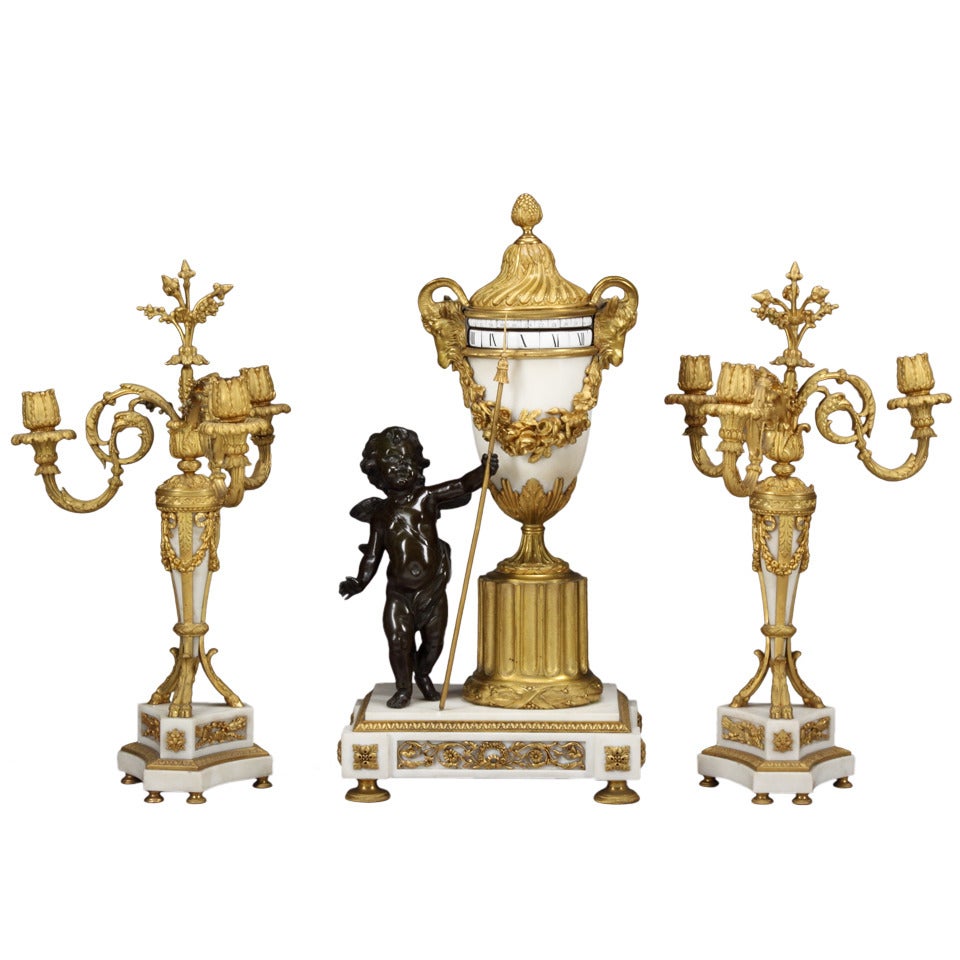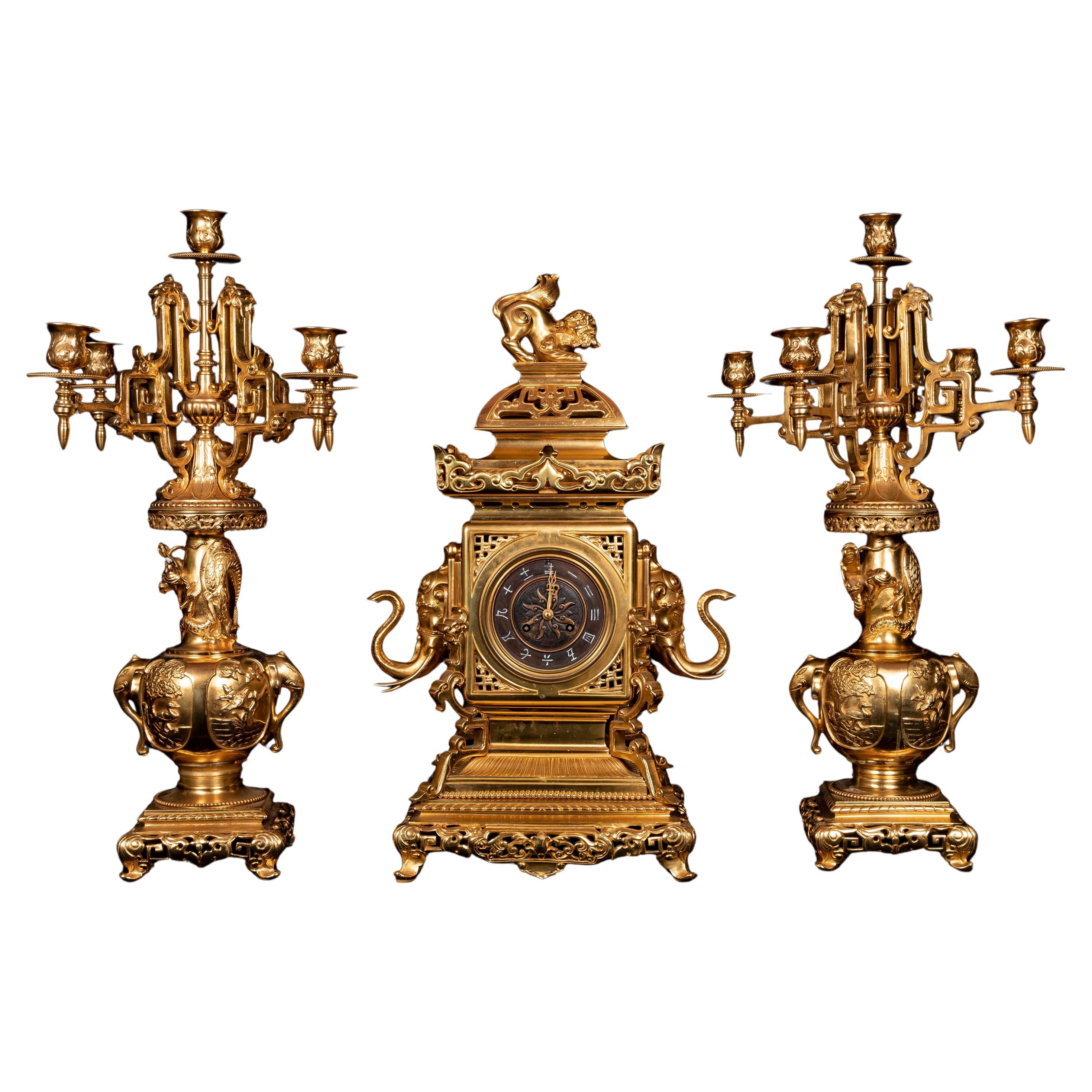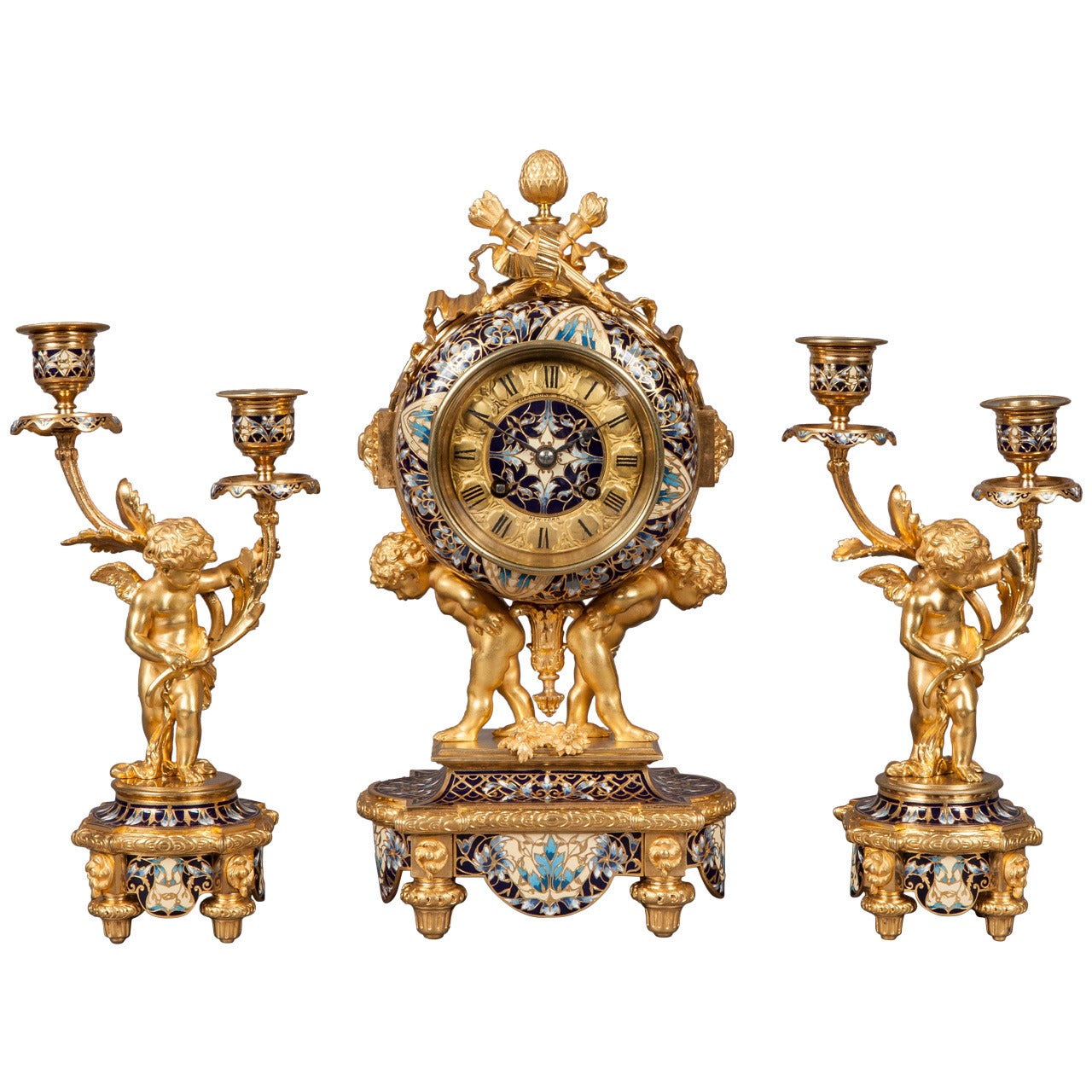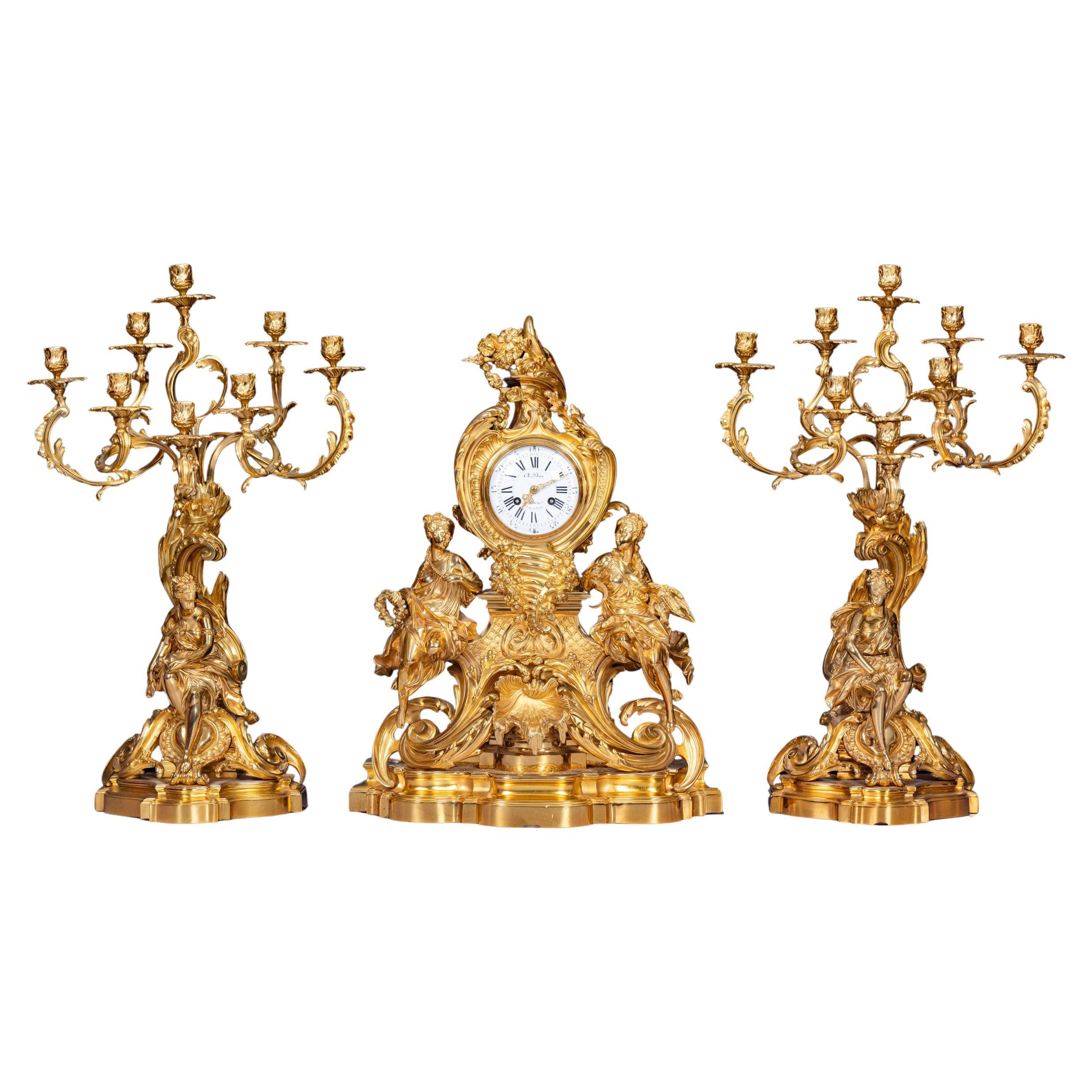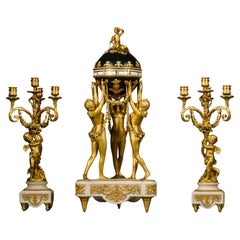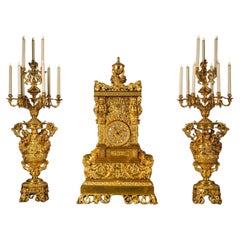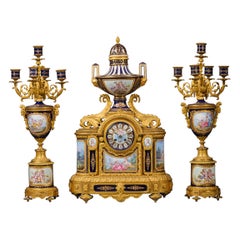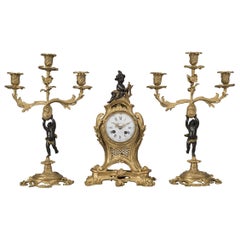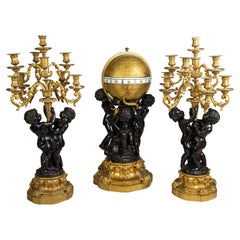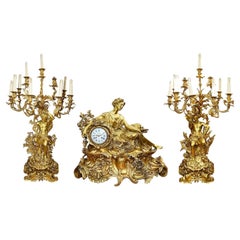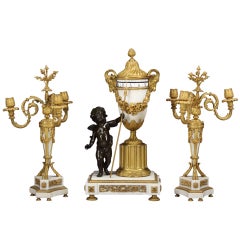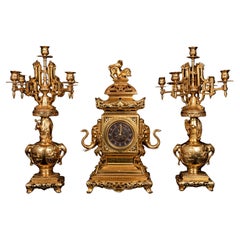Items Similar to Cercles Tournants Clock Garniture by Deniere, Paris
Want more images or videos?
Request additional images or videos from the seller
1 of 12
Cercles Tournants Clock Garniture by Deniere, Paris
$120,834.70
£88,000
€102,992.49
CA$166,699.92
A$183,249.08
CHF 96,307.31
MX$2,225,311.22
NOK 1,201,409.48
SEK 1,138,251
DKK 768,658.99
About the Item
A Rare and Exceptional Gilt and Patinated Bronze Monumental Cercles Tournants Clock Garniture, by Deniere, Paris.
The backplate signed 'DENIERE A PARIS 3088'.
This large and imposing clock garniture comprises a finely chased cercles tournants clock in the form of a terrestrial globe supported by three paintated bronze putti, accompanied by a pair of eight-light candelabra en-suite, modelled after a design by Jean-Louis Prieur (1732-1795).
The eight-day twin-barrelled clock movement striking on a bell is contained within a terrestrial globe with two rotating enamelled dials with Roman numerals for the hours and Arabic numerals for the minutes, a gilt bronze snake wrapping around the base of the globe indicating the time. The globe is supported by three finely cast patinated bronze putti on a rockwork base with an overturned vase issuing water, emblematic of the Oceans and raised on a gilt-bronze acanthus cast re-entrant plinth base.
The candelabra en-suite are each modelled as a pair of patinated bronze putti on naturalistic bases with a conforming acanthus cast gilt-bronze plinth, holding aloft a foliate stem issuing eight candle arms terminating in circular drip-trays cast with ‘C’-scrolls, and octagonal candle nozzles cast with guilloche and shell decoration.
This exceptional clock is after an eighteenth century model, one example of which is in the collection of Victoria and Albert Museum, London. (Illustrated, Tardy, French Clocks the World Over, Paris, 1981, p. 101).
A further eighteenth century example, with a movement by Jean Romilly was owned by the celebrated collector, the 4th marquess of Hertford and kept at the château de Bagatelle, the former home of the Comte d’Artois. (Photographed in the salon at Bagatelle by Charles Marville, reproduced, B. Pons, French Period Rooms 1650-1800, Dijon, 1995, p. 60). Inherited by Sir Richard Wallace, and later Sir John Murray Scott, the clock was eventually sold by Christie’s, London, June 24-26, 1913, lot 258, for £241.10s to the dealer Wertheimer.
French, Circa 1860.
Dimensions
The clock
Height : 80 cm / 31 inches
Diameter : 35 cm / 14 inches
The candelabra
Height: 88 cm / 35 inches
Width: 42 cm / 17 inches
Depth: 30 cm / 12 inches
- Creator:Jean-François Denière (Maker)
- Dimensions:Height: 34.65 in (88 cm)Width: 16.54 in (42 cm)Depth: 11.82 in (30 cm)
- Style:Louis XVI (In the Style Of)
- Materials and Techniques:
- Place of Origin:
- Period:
- Date of Manufacture:Circa 1860
- Condition:Wear consistent with age and use. The movement is clean and running, we canot however provide any guarantees for mechanical devices and would always recomend having clocks overhauled and setup by a qualified clocksmith.
- Seller Location:Brighton, GB
- Reference Number:Seller: B760001stDibs: LU1028035176452
About the Seller
5.0
Recognized Seller
These prestigious sellers are industry leaders and represent the highest echelon for item quality and design.
Established in 1964
1stDibs seller since 2014
58 sales on 1stDibs
Typical response time: 6 hours
Associations
The British Antique Dealers' AssociationLAPADA - The Association of Arts & Antiques Dealers
- ShippingRetrieving quote...Shipping from: Brighton, United Kingdom
- Return Policy
Authenticity Guarantee
In the unlikely event there’s an issue with an item’s authenticity, contact us within 1 year for a full refund. DetailsMoney-Back Guarantee
If your item is not as described, is damaged in transit, or does not arrive, contact us within 7 days for a full refund. Details24-Hour Cancellation
You have a 24-hour grace period in which to reconsider your purchase, with no questions asked.Vetted Professional Sellers
Our world-class sellers must adhere to strict standards for service and quality, maintaining the integrity of our listings.Price-Match Guarantee
If you find that a seller listed the same item for a lower price elsewhere, we’ll match it.Trusted Global Delivery
Our best-in-class carrier network provides specialized shipping options worldwide, including custom delivery.More From This Seller
View AllA Louis XVI Style Gilt and Patinated Bronze and Marble Clock Garniture
By Jollet & Cie
Located in Brighton, West Sussex
A Louis XVI Style Gilt and Patinated Bronze and Marble Clock Garniture, Comprising a 'Pendule à Cercles Tournants' Modelled with the Three Graces and a Pair of Cherub Four-Light Cand...
Category
Antique 19th Century French Louis XVI Mantel Clocks
Materials
Marble, Ormolu
A Monumental Renaissance Revival Clock Garniture, Attributed to Feuchère
Located in Brighton, West Sussex
A Large and Important Louis Philippe Period Gilt-Bronze Three-Piece Clock Garniture.
Attributed to the Feuchère family. The clock movement by Hémon.
In the Renaissance revival style. Comprising a clock and a pair of nine-light candelabra. The clock case of architectural out-shape with cherubic term figures supporting a rectangular pediment centred by an urn. The sides of the clock tower cast in relief with strapwork and foliage. The dial inset with enamel Roman numeral chapters. The twin-barrel clock movement with tic-tac escapement, silk suspension and countwheel strike to bell. Pendulum and winding key.
The candelabra as twin-handled vases supporting tiered branches with candle nozzles. Modelled en suite with naturalistic scrolls and foliage. Surmounted by finials modelled as an eagle toying with a serpent. The scrolled handles flanked by cherubic figures and serpents. The bodies fronted by bacchic masks and supported on socles bearing angels.
France, Circa 1835.
The clock movement signed ‘HEMON A PARIS’. The clockmaker Claude Hémon was established at rue de St. Martin circa 1810-1820.
Dimensions, the clock:
Height : 106 cm 42 inches
Width : 58 cm 23 inches
Depth : 38 cm 15 inches
Weight : 72 kg
Dimensions, the candelabra:
Height : 104 cm 41 inches
Width : 36 cm 14 inches
Depth : 36 cm 14 inches
Weight : 28 kg (each)
This magnificent clock garniture of palatial size is designed in the Renaissance revival style and dates to the Louis Philippe period. Executed in sculptural gilt-bronze with leaves, scrolls, masks and exotic birds, the naturalistic ornament represents an elaborate system of allegories and mythological iconography which recall the influence of Italian Mannerist art in France.
The distinctive design reflects a new style which replaced the neoclassism of the French Empire period. With the fall of Napoleon Bonaparte, artists and designers sought a new decorative vocabulary with which to aggrandise the Bourbon restoration. With the French revolution and Louis XVI’s execution still within living memory, it seemed too soon for a revival of the style of the Grand Siècle. Instead they looked further back to the time of François I, whose patronage of Italian artists had brought the Renaissance to France. The idea of a renaissance revival appealed to the new Bourbon monarchs and their patronage ignited great creativity in the arts.
The reigns of Louis XVIII and Charles X, who were brothers of the late King, Louis XVI, and later of Louis Philippe I, nicknamed the Citizen King, coincided with the enlightenment and the dawn of the industrial age. Great technical progress was made in metallurgy and casting which raised the art of bronze making to new heights in the hands of great masters such as Pierre-Philippe Thomire (1751-1843) and Pierre- Jean-François Denière (1774-1866).
The renaissance provided a rich and varied source book in architecture, furniture and other decorative arts for designers such as Claude Aimé Chenavard (1798-1838) whose Album de l’ornemaniste (1835) became a reference work. Léon Feuchère (1804-1857) also produced drawings of interiors, silver, bronzes and furniture and was a scion of the prominent family of bronze castors established by his grandfather Pierre-François Feuchère (1737-1823) who had worked as a gilder for the bronze caster Pierre Gouthière before setting up a bronze foundry that would become one of the largest in Paris under the management of his son Lucien-François (d. 1841) and grand-son Armand (1797-1866). A number of drawings by Léon Feuchère have recently been discovered by the Rijksmuseum and probably belonged to the collection of Louis-Philippe-Albert, duc d’Orléans, comte de Paris (1838-1894). Louis-Philippe-Albert was the grandson of the French king, Louis-Philippe I (1773-1850), who granted him the title of comte de Paris, and the son of Ferdinand-Philippe, duc d’Orléans (1810-1842). Ferdinand-Philippe was an important collector and sponsored many young artists to create metalwork objets d’art, notably a celebrated surtout de table made by Claude-Aimé Chenavard and Jean-Jacques Feuchère (1807-1852), a cousin of Armand and Léon. Principally remembered as a sculptor, Jean-Jacques Feuchère trained in the family foundry and designed small objects, cigar boxes...
Category
Antique Early 19th Century French Renaissance Revival Mantel Clocks
Materials
Bronze
Napoléon III Sèvres Style Clock Garniture
Located in Brighton, West Sussex
A fine Napoléon III gilt-bronze and sèvres style cobalt blue ground 'Jewelled' Porcelain Three-Piece Clock Garniture
Comprising a mantel clock and a pair of five-light vase candel...
Category
Antique 19th Century French Napoleon III Mantel Clocks
Materials
Ormolu
Louis XV Style Bronze Figural Clock Garniture by Maison Baguès French circa 1870
By Maison Baguès
Located in Brighton, West Sussex
A fine Louis XV style gilt and Patinated bronze figural clock garniture by Maison Baguès.
This rare example of a clock garniture by Maison Baguès has a twin train eight-day movement striking on a bell.
The garniture consists of a clock and a pair of candelabra en suite.
The clock has a Rococo cast case surmounted by a patinated bronze putto playing a lyre, above a circular white enamel dial with Roman numerals, Arabic seconds and pierced hands. The dial inscribed 'Eug Bagues, Paris'. The case terminates in four scrolling legs put down on an acanthus cast plinth base.
The candelabra en suite have gilt bronze pierced acanthus cast bases supporting patinated bronze putti each holding aloft three scrolling acanthus arms terminating in circular and foliate cast drip trays and nozzles.
Maison Baguès
The Baguès Company, located at 31, rue des Francs-Bourgeois, was founded in 1840 by Mr. Noel Baguès who started his business to cast liturgical bronzes.
By 1880 the company had expanded into the production of bronze light fixtures in response to the development of electrical lighting. Carried on by Noël’s son Eugène and grandsons Victor and Robert, Maison Baguès continued to progress, adding intricately detailed iron lighting collections in the 1920s as well as stair banisters...
Category
Antique Mid-19th Century French Louis XV Mantel Clocks
Materials
Bronze
A Napoleon III Period Sèvres Style Porcelain Three-Piece Clock Garniture
By Jean-François Denière
Located in Brighton, West Sussex
A Large and Exceptional Napoleon III Period Gilt-Bronze and Sèvres Style Porcelain Three-Piece Clock Garniture. By Denière, Paris.
Comprising a mantle clock and pair of eight-light...
Category
Antique 19th Century French Napoleon III Mantel Clocks
Materials
Enamel, Ormolu
A Fine Napoléon III Gilt-Bronze Three Piece Clock Garniture
Located in Brighton, West Sussex
A Fine Napoléon III Gilt-Bronze Three Piece Clock Garniture
Comprising a mantel clock and a pair of seven-light figural candelabra. Designed as a celebration of music and lyric poe...
Category
Antique 19th Century French Napoleon III Mantel Clocks
Materials
Enamel, Ormolu
You May Also Like
Important Cercles Tournants Rotary Clock set by Deniere
By Maison Deniere
Located in Los Angeles, CA
Very Large Important and Rare Napoleon III Period Ormolu And Patinated Bronze Sculptural rotary 3-piece clock set ("Pendule A Cercles Tournants") compr...
Category
Antique 19th Century French Napoleon III Mantel Clocks
Materials
Bronze
Price Upon Request
Important 19th Century French clock garniture by Deniere.
By Maison Deniere
Located in Brighton, Sussex
A wonderfully impressive 19th Century French gilded ormolu clock garniture, by Deniere of Paris. The clock having a classical reclining maiden holding doves among flowers and foliage...
Category
Antique Late 19th Century French Louis XVI Mantel Clocks
Materials
Ormolu
Unusual 19th Century French rotary Clock Garniture
Located in Los Angeles, CA
A rare and very fine 19th century French Louis XVI style ormolu mounted white marble 3-piece Rotary (Annular) clock set comprising a clock and a pair of 3 arms candelabra.
The urn s...
Category
Antique 19th Century French Louis XVI Clocks
Materials
Marble, Ormolu
$29,500 / set
Large French Japonisme Ormolu Garniture Clock Set Attributed to Edouard Lievre
By Edouard Lievre
Located in New York, NY
A magnificent and finely cast palatial and very large French 19th century Japonisme three-piece ormolu garniture clock set attributed to Edouard Lievre. This striking and extremely u...
Category
Antique 19th Century French Japonisme Table Clocks and Desk Clocks
Materials
Bronze
French Mantle Clock Garniture in the Louis XVI Manner
Located in London, GB
Constructed in gilt bronze and decorated with champleve´ enamel; the candelabra have toupie feet supporting the shaped circular bases, on which winged cherubs hold two armed candle a...
Category
Antique 1880s French Louis XVI Clocks
Materials
Enamel, Ormolu
19th Century Louis XV Style Gilt Bronze Clock Garniture By Ch. Drieu, Paris
Located in Dublin, IE
A stunning 19th century ormolu clock garniture in the Louis XV style by Ch. Drieu, the white enamel with Roman numerals signed “Ch. Drieu, 4 Rue de Thorigny”. The clock is flanked by...
Category
Antique 19th Century French Rococo Mantel Clocks
Materials
Enamel, Ormolu
More Ways To Browse
Bronze Putti
Paris Bronze Mantel Clocks
Monumental Clock
Deniere Bronze
Museum Clock
Deniere A Paris
Cercle Tournants
Antique French Clock Cercle Tournant
Cherubs Garlands
19th Century French Lyre Clock
Bronze Garniture Sets
Antique Wind Up
Cherub Plaque
French Empire Figural Mantel Clock
Antique French Bell
German Mantel Clock
Antique Art Deco Mantel Clock
Art Deco Marble Mantel Clock
